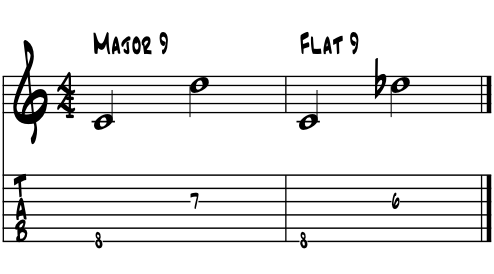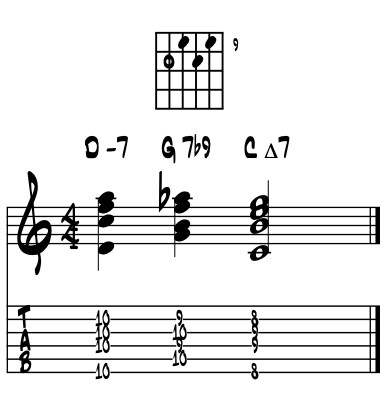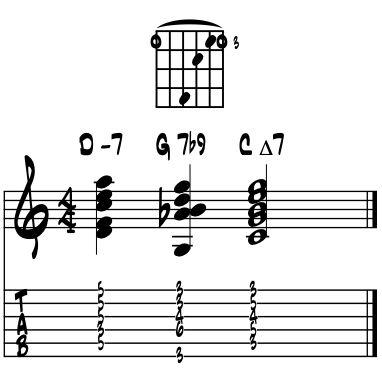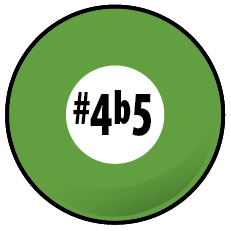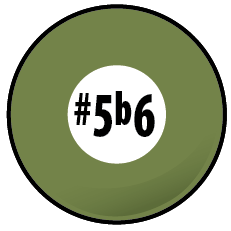~ b9 ~ flat Nine ~ minor 9th ~ ~ completes fully diminished 7th chord of V7b9 ~ ~ multiple tonic resolution vectors of varying tonal gravities ~
|
'Flat Nine nutshell.' Is the flat nine interval our most dissonant among them all? In aural sound and numerical ratio it just bristles and grates and yet ... So finding our own way to using the b9 color in our music can be a giant step for each and every one of us, when and if it happens. For in both chordal and single line playing, once we 'accept' the color as a functioning part of the V7 type tensions, a wide world of jazz leaning opportunities for shaping melodies and cadential motions presents itself well beyond this rather cantankerous sounding pitch. |
Beyond the octave. As we move into our second octave as measured above our tonic pitch, the lower octave 'simple' intervals give way to the upper 'compound' intervals. In this first chart we add our numerical designations into two full octaves of the C major scale. Example 1. |
 |
Finding b9. So it just seems that whenever we can write out the pitches with corresponding numbers, it's amazing how quickly the pitch we need just pops right up. In the following chart we find diatonic nine in C major and simply lower it, or 'flat' it, by half step to find flat Nine. Example 2a. |
|
Clear as mud? Cool, thought so. While b9's best pal in this is probably the #9 color of "Born To Be Wild" fame, and all over blues and rock, in all honesty if you're not a jazz player this b9 interval is probably not going to become a 'go to' color for Ya. |
Looking to lose the gig? Working yourself out of a job? Want to get some revenge on the club owner? Then adding in the flat Nine color, into folk, pop and most blues and rock tunes and music just might do the trick. |
Although ... this 'b9' dissonance might just work perfect for the metalists. From the inception of the genre back with bands like Deep Purple in the late 60's forward, modern metalists have surely embraced the dissonance / tritone interval, and so not to be a bit surprised if the flat Nine is in ascendency, or already landed for that matter, as this page is being written ( June 2016 ). |
|
So where is flat Nine the music ? Almost exclusively a jazz color. The flat Nine color is nearly always associated with dominant harmony. While quite rare in written melody lines, many players spice up their improvised single note lines with flat Nine. |
As part of our V7 family of chords, the flat Nine color finds its way into some interesting combinations with its color tone brethren, i.e., b5, #11, 13 etc. Hear the flat Nine sounds in action first, then we'll explore its theory. Thinking V7b9 to One in the key of C major. Example 3. |
Cool ? A one of a kind sound ? Pretty much. Sing the line ? Beyond tricky. |
As a passing tone. Even without the V7b9 chordal color supporting, advancing players will use the b9 color as a passing tone over V7. In this next idea we create a purely diatonic melody over the essential jazzy Two / Five / One cadential motion, and by half step, wiggle in b9 just prior to making our resolution. A very common jazz idea with 'b9' as a passing tone. Example 3a. |
That's a bit more civilized eh ? Knowing that flat Nine is one of 'the other five pitches', left over after using seven of our 12 total to build up the diatonic relative major / minor pairing helps to locate it. Yep, 7 + 5 = 12. |
Some of the theory of V7b9. There are two fairly essential aspects of V7b9 chords to consider. The first is as a root position chord and how it works within a given key center. Nothing really heavy here, although having the core ability to spell chords is the great facilitator. |
The second aspect of b9 theory revolves around the idea that within the V7b9 chord lives another chord; a fully diminished 7th chord. And that this chord's pitches can open up some solid traditional theory avenues for exploration for the modern guitarist. |
Think from the root. 'Think from the root of the chord ol' boy and you'll never get lost.' That was Dr. Miller's quip when deciphering these chordal colors during our studies in college. There's just three easy steps to Doc's process, and it works like a charm. Goes like this. |
First we determine our key center and spell out its diatonic scale. Then reconfigure the scale into its arpeggio. And from the arpeggio we spell out the letter names of our chords and make any necessary alterations for the colortones. If necessary, examine this steps in the following chart, in the key of C major, and start out by digging out the pitches of our G9 chord. Example 4. |
scale degree |
root (1) |
2 |
3 |
4 |
5 |
6 |
7 |
8 |
scale pitches |
C |
D |
E |
F |
G |
A |
B |
C |
arpeggio degree |
root (1) |
3 |
5 |
7 |
9 |
11 |
13 |
15 |
arpeggio pitches |
C |
E |
G |
B |
D |
F |
A |
C |
The thought process. We start out looking for the Five chord in the key of C major. We know its root pitch is G. Locate that pitch in the arpeggio and spell out its third, fifth, seventh and ninth degrees. We do need a b9 though. So lowering our ninth, the A natural, by half step i.e., 'flat the Nine', that will feed this bulldog. Ex. 4a. |
scale degree |
root (1) |
2 |
3 |
4 |
5 |
6 |
7 |
8 |
scale pitches |
C |
D |
E |
F |
G |
A |
B |
C |
arpeggio degree |
root (1) |
3 |
5 |
7 |
9 |
11 |
13 |
15 |
arpeggio pitches |
C |
E |
G |
B |
D |
F |
Ab |
C |
A simple trick. In all of this spelling of our chords using the above method, once we develop the ability to mentally slide our arpeggio numbers, the 1,3,5,7, etc., so that our root pitch / 1 is above the root of the chord we are spelling, we're golden, i.e., 'to think from the root.' Here's this thought process in chart form. Example 4b. |
scale degree |
root (1) |
2 |
3 |
4 |
5 |
6 |
7 |
8 |
scale pitches |
C |
D |
E |
F |
G |
A |
B |
C |
arpeggio degree |
root (1) |
3 |
5 |
7 |
9 |
11 |
13 |
15 |
arpeggio pitches |
C |
E |
G |
B |
D |
F |
A |
C |
arpeggio degree |
. |
. |
1 |
3 |
5 |
7 |
b9 |
3 |
chord pitches |
. |
. |
G |
B |
D |
F |
Ab |
. |
Cool? Do this enough and it can become second nature. Rote learning? Yep. Old fashioned learning ! Plus, do remember that there are only so many chords to spell. And while in theoretical possibilities that's probably a thousand or so chords, as you begin to play through standard tunes you'll often see the same chords again and again, and again, and again. And once we do we'll search for newness and variety. |
Time / swing. Getting a V7b9 color super solid under our fingers enables us to begin to confidently use its b9 dissonance. So empowered, we can near instantly feel a new sense of depth with our swing. For if dissonance of sound creates a stronger sense of the 'pull' to resolve, the 'b9' color is a crown jewel. Feeling this newness of swing is for some artists a life changing event. For there are many other dissonances to explore; individually as pitches or in various combinations, each of which create their own unique sense and degree of swing. |
Some common flat 9 voicings. When first getting to b9, there are a couple of potentially essential V7b9 chord voicings for the emerging modern guitarist. In this next idea we slip these V7b9'ers between the Two and One chords, creating a few sleek and movable cadential motions. Each are numbered and then theoretically examined sequentially. Thinking C major, the following ideas evolve for V7b9. Example 5. |
 |
Wow, yea there's some trickery in there. Find a fave, master it. Then on to the next. There's only a few for the first valence or so of jazz guitar. As you hear the colors better and better, and accept the new ones to function as evolutions of the established tried and true ones, new ways unfold to cover common ground found through our songbooks, that will have a print of your own artistic signature in them. It's the searching part of the lifelong study of art, which knowing the theory helps us do. |
Two / Five / One. The above examples include the three chord types that we can use to classify chords. The idea of chord type simply groups together chords as based on their interval construction, thus each type tends to function in similar ways in the music. Similar form, similar function, similar theory. Let's examine each Two / Five / One grouping from the example just above. |
# 1. This first grouping is probably the most common of these cadential motions. 100 % root position movable. Great shapes for both chomping a la Freddie Greene or comping. Four unique notes per chord, solid. Ex. 5a. |
|
Jazz leaning? Consider mastering these last three shapes. |
# 2. A very cool voicing, probably the most advanced voicing of the three included here. A malleable shape too, that evolves a bit to other colors and easily moves up and down the neck. Removing the root pitch anchor of this shape frees it to move and morph. Example 5b. |
Jazz leaning? Consider mastering these last three shapes. |
# 3. Ya might leave the root pitch out of this voicing if you've got a bass player. If not, try fingering it as a barre chord, thumb over of sound the bass note first, then play the chord. Sans the root pitch and the shape becomes very common, malleable and super movable to the evolving guitarist. Notice that we've a fully diminished 7th chord above the G root. Example 5c. |
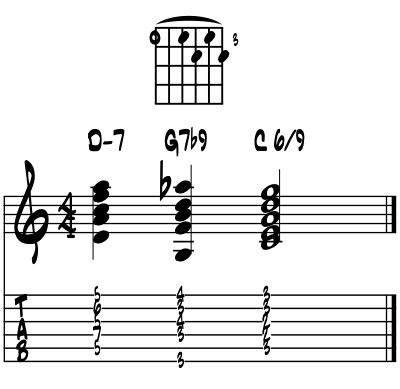 |
Jazz leaning? Consider mastering these last three shapes. Super movable? Yea, try moving that four note, four string shape up and down the neck. Need a total 'Django' styled move ? This one leans that way. |
|
# 4. In this next idea, we evolve the Two and Five chord by creating chord inversions. Lightening the texture thus, we then move our diminished chord up a minor third interval as a constant structure and resolve. Taking advantage of the diminished chord's symmetrical minor third construction, this sort of constant structure motion is a potential game changer for the jazz leaning, modern guitarist. Example 5d. |
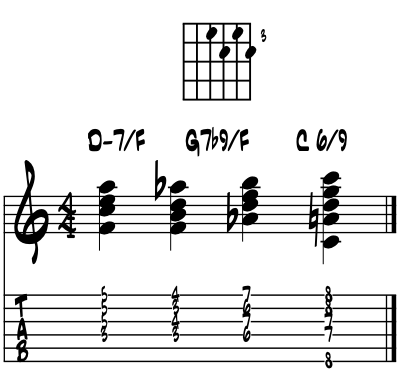 |
Need a lick that jumps ya stem to stern ? There it is, well one of them, of many, anyway :) |
Why the game changer. For two essential reasons. First that advancing players will take advantage of the multiple leading tone properties of the fully diminished 7th chord that lives within V7b9 to create additional cadential solutions. These four leading tones each direct us equally to their respective major or minor tonalities. This in itself opens up a wide artistic potential. These possibilities become 'legal' theoretical / artistic forces to shape our tonal journeys. |
Second, that the perfect symmetrical construction of the diminished chord creates an ability to smoothly move the four note voicing by its core construction interval of the minor third. This parallel motion of the diminished 7th chord pitches, in minor thirds / three frets on our guitars, we just keep scrambling around these same four pitches. Scrambling? Well not quite like ham 'n eggs. Similar yet different as the saying goes. And it goes just like this. |
Diminished / V7b9. First, let's extract and identify the pitches of our fully diminished 7th chord from within V7b9. Here is the chart from above expanded and now altered a bit to include our flat Nine colortone. Thinking in 'C' major, our Five chord is rooted on 'G.' Ex. 6. |
scale degree |
root (1) |
2 |
3 |
4 |
5 |
6 |
7 |
8 |
scale pitches |
C |
D |
E |
F |
G |
A |
B |
C |
arpeggio degree |
root (1) |
3 |
5 |
7 |
9 |
11 |
13 |
15 |
arpeggio pitches |
C |
E |
G |
B |
D |
F |
A |
C |
arpeggio degree |
. |
. |
1 |
3 |
5 |
7 |
b9 |
3 |
V 7b9 pitches |
. |
. |
G |
B |
D |
F |
Ab |
. |
diminished chord pitches |
. |
. |
. |
B |
D |
F |
Ab |
. |
Scramble 'em up. Having extracted the four pitches of our perfectly symmetrical, fully diminished chord from G7b9, we can then scramble them up using their interval construction into pitch motion of the minor third. Thinking of B diminished 7th within V7b9. Example 6a. |
scale degree |
root |
-3 |
dim 5 |
dim 7 |
B diminished 7th |
B |
D |
F |
Ab |
1st inversion |
D |
F |
Ab |
B |
2nd inversion |
F |
Ab |
B |
D |
3rd inversion |
Ab |
B |
D |
F |
4th inversion |
B |
D |
F |
Ab |
Four's a charm. The idea that the pitches of this chord perfectly invert into one another is the key to this magic highway. Notice we use the term inversions in the above chart ? Cool with chord inversions ? Four pitches in the chord allows us four inversions n'est-ce pas? First, second, third and fourth a each can be the root, -3rd, dim 5th or dim 7th. Did we just break our 'think from the root rule ? Ye we might have, sorry. Regardless, here are the above pitches, adjusted into two common diminished chord shapes, creating an ascending, resolving motion to C major. Example 6b. |
 |
A potential essential motion. Artists can get some mileage out of this minor third ascending motion. Descending too. Mastering the diminished chord's energy as presented above develops the core physical motion that can play huge for the modern jazz guitarist. With the minor third also being a core American blues interval, it just comes up near everywhere in the musics. |
Once the accuracy is mastered and the tension and release or tonal gravity of the line is clear, our ever evolving searching encourages us to soften up the colors and gradually part up the minor third interval into slimmer and slimmer, chromatic windows. This allows us to search, find and understand the coolness within its basic boundaries. Motion down a minor 3rd, ends up making a '3 6 2 5' motion, with VI being V7b9, the diminished chord that moves, into the double Two Five, a half step a part. Emerging in the mid 50's as a new / old way forward, this simple trick restructured any Two / Five idea with some new coolness and thus challenge, for the improvising artist. And a bit further up the road, the interval of the minor 3rd combines with the more common cadential motion bass of a perfect fourth. Those in the know will know that minor 3rd / perfect 4th motions become the harmonic motion of Coltrane's "Giant Steps." |
Four leading tones / four V7b9 chords. In this next idea we simply resolve the same diminished chord to its four possible major key tonics. Dig into this a bit and root out the leading tone's and examine their resolutions. Do notice that the key centers we resolve to are also spaced by the minor third interval. Example 6c. |
 |
So a couple of choices. So each pitch of the fully diminished 7th chord can be a leading tone pitch to its parent key; major and minor? Yep. In the minor tonality, we're off of the relative pairing just a wee bit, as we're borrowing this non-diatonic, raised 7th leading tone and 'b6' from the harmonic minor scale, but these diminished resolutions in minor chord progressions and cadences are a common occurrence. Here the square pegs of the theory begin to fit nicely into the round holes of the music, an art which is way more forgiving than its rules. |
Evolutions. Eventually we'll work our way back from the fully diminished 7th sounds to softer colors of half diminished, melodic minor and V7, while retaining these minor 3rd motion resolving properties. In this text we call these possibilities our 'modern motions.' |
This property of multiple leading tones becomes the catalyst for much of the evolution, in theory anyway, of Americana jazz harmony, which helps to shape the composing and improvisations through the last 100 years or so. |
Review and forward. Conquering the flat Nine / b9 colortone is oftentimes a giant step forward for many players. It's a paradigm shift really. If this aural color is acceptable and beginning to find places in your music, chances are your heading in a jazz direction and getting your arms around the full 12 tone palette. |
|
Key components of flat Nine include its minor 3rd symmetry, moving notes and chords by interval of minor 3rd, the multiple leading tones as found within the fully diminished 7th chord pitches, and the gradual softening of the diminished sounds while retaining its principles of minor 3rd motions. |
"When you’re onstage or recording, you put yourself in those stories." |
wiki ~ George Jones http://www.nytimes.com; 04/26/13 |
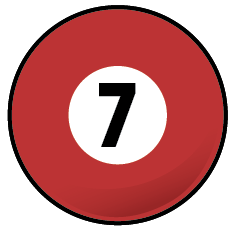 |
 |
|||||||||||
 |
 |
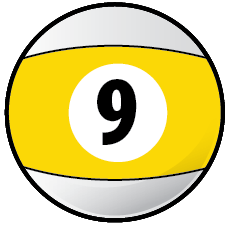 |
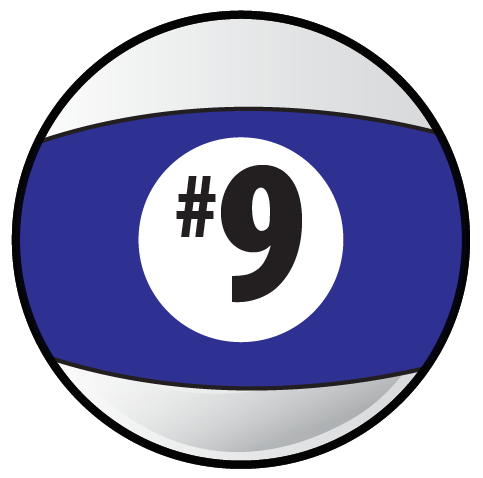 |
 |
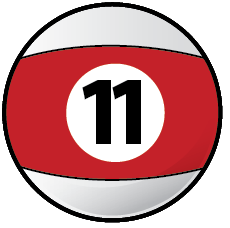 |
 |
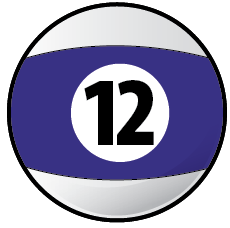 |
 |
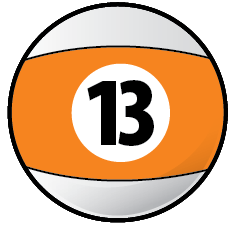 |
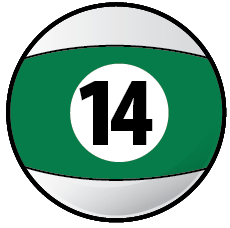 |
 |
 |
References. References for this page come from the included bibliography from formal music schools and the bandstand, made way easier by the folks along the way. In addition, books of classical literature; from Homer, Stendahl and Laudurie to Rand, Walker and Morrison and of today, provided additional life puzzle pieces to the musical ones, to shape the 'art' page and discussions of this book. Special thanks to PSUC musicology professor Dr. Y. Guibbory, who 40 years ago provided the initial insights of weaving the history of all the fine arts into one colossal story telling of the evolution of AmerAftroEurolatin musical arts. And to teacher-ed training master, Dr. Joyce Honeychurch of UAA, whose new ideas of education come to fruition in an e-book. |
"Life is about creating yourself." |
wiki ~ Bob Dylan |
Find an e-book mentor. Always good to have a mentor when learning about things new to us. And with music and its magics, nice to have a friend or two ask questions and collaborate with. Seek and ye shall find. Local high schools, libraries, friends and family, musicians in your home town ... just ask around, someone will know someone who knows someone about music who can help you with your studies of the musical arts with this e-book. |
Intensive tutoring. Luckily for musical artists like us, the learning dip of the 'covid years' can vanish quickly with intensive tutoring. For all disciplines; including all the sciences and the 'hands on' trade schools, that with tutoring, learning blossoms to 'catch us up.' In music ? The 'theory' of making musical art is built with just the 12 unique pitches, so easy to master with mentorship. And in 'practice ?' Luckily old school, the foundation that 'all responsibility for self betterment is ours alone.' Which in music, and same for all the arts, means to do what we really love to do ... to make music :) |
 |
"These books, and your capacity to understand them, are just the same in all places. Always bear in mind that your own resolution to succeed, is more important than any other one thing." |
|
Academia references of Alaska. And when you need university level answers to your questions and musings, and especially if you are considering a career in music and looking to continue your formal studies, begin to e-reach out to the Alaska University Music Campus communities and begin a dialogue with some of Alaska's finest resident maestros ! |
|
Formal academia references near your home. Let your fingers do the clicking to search and find the formal music academies in your own locale. |
"Who is responsible for your education ... ? |
'We energize our learning in life through natural curiosity and exploration, and in doing so, create our own pathways of discovery.' Comments or questions ? |

